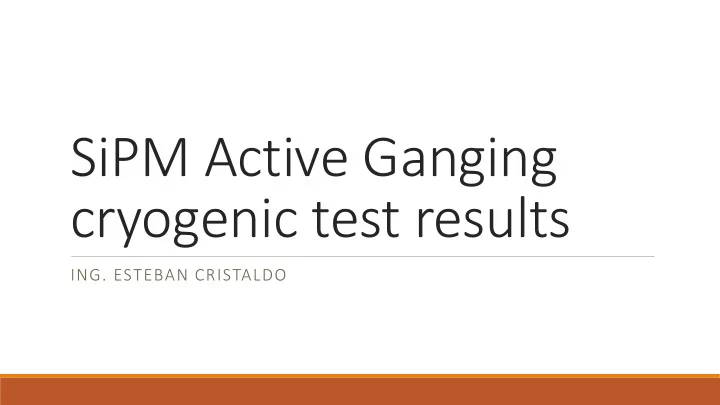

SiPM Active Ganging cryogenic test results ING. ESTEBAN CRISTALDO
Prototype V1 Prototype V2
Prototype V1 • Three stage amplifier. • First stage consist in 4 transimpedance amplifiers, each amplifying groups of 12 SiPM’s • Second stage is a single ended summing amplifier. • Third stage is a Differential Low Pass Filter in multiple feedback configuration. It provides single ended to differential conversion. • LMH6629 was used for single ended amplification and LMH6554 for differential amplification.
Prototype V1 test summary • Prototype V1 did not meet operation conditions due to high instability of the single ended stages (LMH6629). • LMH6554 introduces distortion in the signal when operating as Low Pass Filter. Voltage inverter configuration was tested but distortion was still present in high amplitude signals. • Stable operation was achieved when stages were separately tested, but once connected oscillatory condition appeared.
Prototype V2 • Two stage amplifier. • First stage consist in 4 transimpedance amplifiers, each amplifying groups of 12 SiPM’s • Second stage of prototype V2 replaced second and third stage of protype V1, providing summing mode and single ended to differential conversion. • OPA847 replaced LMH6629 and THS4131 replaced LMH6554.
Prototype V2 test summary • Prototype V2 meet operation conditions at room and cryogenic temperatures. • Distortion in the signal was not present, even with large signals. • Low amplitude, high frequency oscillatory condition was present. This was mitigated adding compensation networks in between stages. • 1 MPPC and 8 MPPC in parallel were tested due to availability of the SiPM’s sensors.
Prototype V1 Prototype V1 was thoroughly tested, but obtaining a satisfactory operation condition was in vane. Prototype V2 achieved satisfactory operation condition. Prototype V2
Prototype V2 test @ room temperature • High frequency, low amplitude oscillatory condition was encountered. • Signal shape distortion and high amplitude oscillation that was present in V1 was mitigated. • Nevertheless, this oscillatory condition in V2 prevented the observation of single photoelectron peaks.
Prototype V2 test @ room temperature • This oscillations where mitigated by adding a compensation network in between stages. • The .gif in the right demostrates in real time the effect of adding this compensation.
Prototype V2 test @ room temperature • Single PE resolution is achieved at room temperature @ 20 V/V gain. Signal from LED Single PE
Prototype V2 test @ LN2
Single PE - 1 MMPC – AMP @ LN2 1 tick = 6.6667 ns
Single PE - 1 MMPC – AMP @ LN2 Histogram of acquired signals 1 tick = 6.6667 ns
Single PE - 8 MMPC – AMP @ LN2 1 tick = 6.6667 ns
8 MMPC – AMP @ LN2 Histogram of acquired signals
Sources of Noise Acquired signals Noise studies in PAB https://indico.fnal.gov/event/21034/ Rory Fitzpatrick
Noise Levels 540 540 𝑇𝑂𝑆 = 20𝑚𝑝 10 180 = 9,5 dB 𝑇𝑂𝑆 = 20𝑚𝑝 10 = 19,08 dB 60 As for now, I can say that this the max SNR is about 9,5 dB due to noise introduced by the environment, and can be optimized to achieve 19 dB.
Dynamic Range • The Dynamic range depends on the first stage (OPA847) • The OPA847 saturates at around 4V and considering that a single PE from 1 SiPM connected @ Vbias 55V and Signal from LED gain of 20 V/V is 2mV peak at room temp. • In this case the dynamic range is about 2000 photons, but increasing the number ganged SiPM increases the dynamic range in detriment of SNR. • Of course, at cryo temperatures the SiPM gain changes and for now I don’t feel confident to throw a number. Single PE • Using a good compensation scheme, the gain in the first stage can be lowered to 4 V/V, which will add more dynamic range. • Using the second amplification stage or a third passive attenuator stage, it could be possible to obtain a required dynamic range.
Recommend
More recommend